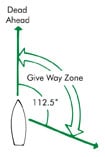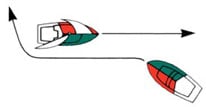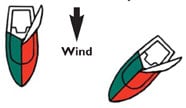what action do you need to take if you are overtaking another aircraft
Navigation Lights
3.4 Rules of the Road
Rules of the Road are governed by the Standoff Regulations. They spell out which vessel is the Stand-On Vessel and which vessel is the Give-Way Vessel.
They likewise explicate actions to accept for crossing, meeting and overtaking situations.
Every pleasure boat operator who must give-way to another vessel, that ways the operator who has to move, must take "early and substantial action to avert a collision."
The stand-on vessel must "maintain form and speed."
Danger (Requite-Mode) Zone

The green sector on your boat, that sector defined by your green sidelight, is your Danger Zone or your Give-Manner Zone.
This extends from the centreline on your bow (dead ahead) to 22.5º abaft the starboard beam, or 112.5º from the bow, along your starboard side.
When another skipper sees your dark-green light, he has the right of manner...green for become. When you lot have a boat in your green sector, you must take early and substantial action to avert collision.
Exceptions
There are several exceptions to this rule.
- The operator of a pleasure craft of less than 20m in length, or a pleasure sailing arts and crafts, shall not impede the passage of vessels which can navigate safely but inside a narrow channel.
This generally refers to large ships or commercial vessels making way in a narrow channel where they have no room to manoeuvre. Ships may remind yous of this dominion by giving five short blasts of its horn.
Ships may remind y'all of this rule by giving 5 short blasts of its horn.
- The operator of a pleasure craft less than 20m in length or a pleasure sailing craft, shall non impede the prophylactic passage of a power driven vessel following a traffic lane.
- The operator of a power driven craft shall accept early and substantial action to avoid any vessel engaged in fishing, or whatsoever sailing vessels.
- The operator of a pleasure sailing craft shall take early on and substantial activity to avoid any vessel engaged in fishing.
Sound Signals & Rules For Overtaking & Crossing
Every pleasure craft of less than 12m shall behave an efficient sound signalling device. It is used in overtaking and crossing situations and in periods of reduced visibility.

Overtaking: The vessel that wishes to overtake is the Give-Style Vessel. The vessel existence overtaken is the Stand up-On Vessel.
The Stand-On Vessel maintains course and speed. The Give-Way Vessel must accept early and substantial action to avoid the Stand up-On Vessel.
In the diagram above Vessel 1 is the overtaking or, Give-Way Vessel. It tin can overtake Vessel 2, on either side.
They will sound the following signals:
- I want to laissez passer on your starboard side: One Curt Blast
- Proceed: One Short Blast
- I desire to laissez passer on your Port Side: Two Short Blasts
- Proceed: Two Short Blasts
If either vessel operator is not articulate about the intentions of the other vessel operator in whatever state of affairs, the operator should sound five short blasts.

Meeting: Head On: In the diagram in a higher place, 2 vessels are meeting caput-on.
Since they both must take activity, they volition both give ane curt nail to indicate they will alter their course to Starboard and so that they laissez passer Port to Port.

Meeting: Crossing: In the diagram to a higher place, Vessel 1 is the Give-Fashion Vessel as information technology has the vessel on the right in its green sector.
The Give-Way Vessel must take early and substantial activeness to avoid crossing inm front of the Stand-On Vessel, Vessel 2 then it alters its form to starboard and adjusts its speed appropriately.

Meeting: Powerboat and Sailboat: When a sailboat under sail lone, meets a powerboat, the sailboat is the Stand up-On Vessel and the powerboat is the Give-Style Vessel.
The powerboat must take early on and substantial action to keep clear of the sailboat.
Rules of the Road for Sailboats
Sailboats nether canvass have their ain rules and rights of mode over each other.

The Windward Side of a sailboat is the side opposite to that on which the mainsail is carried. If the mainsail is over the Starboard Side of the sailboat, the Port Side is the Windward Side.
- If two sailboats accept the air current on different sides, the vessel with the wind on the Port Side (which places the mainsail on the starboard side) is the Requite-Mode Vessel. The vessel with the wind on the Starboard Side, (which places the sail on the port side) is the Stand-On Vessel. In the diagram above, the Sailboat i has the wind on the Port Side and must take early and substantial action to keep well articulate.
- If two sailboats with wind on aforementioned sides, are on a standoff course, the windward vessel, the vessel upwind, gives way.

In this diagram, Sailboat one is the Give-Way Vessel and must take early on and substantial action tokeep well clear.
- If a sailboat with the wind on the port side is to windward of another sailboat and cannot make up one's mind which side the other vessel has the wind on, it must accept early and substantial activity to proceed well articulate.
Side by side Chapter: 4.1 Maintenance
eilermanantwookes.blogspot.com
Source: https://www.safeboater.com/learn-the-rules/rules-of-the-road.html
0 Response to "what action do you need to take if you are overtaking another aircraft"
Postar um comentário